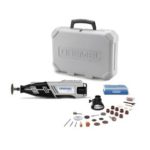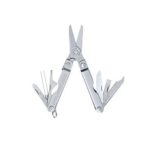When it comes to plumbing, there are many different types of fittings and connectors that can be used. Two of the most popular types are PEX crimp vs clamp. So, what’s the difference?
In this blog post, we will discuss the pros and cons of each type of connector, and help you decide which is best for your needs.
What is a PEX Crimp?
A PEX crimp fitting is a quick and easy way to connect pipes together. It’s made of copper or brass, which makes them strong and reliable. The metal can also be coated in zinc for extra protection against corrosion.
A crimp is a metal ring that slides over the joint and is squeezed down by the crimping tool. Copper crimps are more durable than clamps, but they are also more prone to rust.
Crimps are often used by plumbers who want to avoid soldering joints on-site because it’s more time-consuming and requires specialized equipment.
What is a PEX Clamp?
A PEX clamp is a connector that uses two metal clamps to hold the pipes together. The clamps are tightened with a clamping tool, which creates a watertight seal.
Clamps are stainless steel bands with tiny pegs and locking holes. When a knob is squeezed with a clamping tool, the peg falls into the correct hole, securing it inside the joint.
Stainless steel clamps are easier to install and less likely to corrode than copper crimps, but they’re also thinner and more prone to bend or break.
What is the Difference Between PEX Crimp and PEX Clamp?
PEX crimp and PEX clamp connections make use of the same fittings, commonly known as “crimp” or “barbed” PEX fittings.
Each procedure necessitates a distinct tool and a distinct sort of ring, although the designs are comparable enough that novice PEX users frequently struggle to determine which technique is best. When done correctly, the two procedures can produce a strong and watertight connection.
1. Versatility
PEX clamps are more adaptable than crimp clamps in certain ways. The main distinction is that you’ll just need one clamping tool for all of your jobs. It will not make a difference what sizes of pipes you will be connecting. You will only require one tool for all of them.
Furthermore, in confined areas, a clamping tool is more convenient. Because they just take a little bit of effort to operate, they’re ideal for tight spots.
Both copper and stainless-steel rings may be clamped with PEX clamping tools.
When using the crimping technique, the crimping tools are only effective for particular PEX fittings. They are available in angle or straight designs with shorter handles. These instruments have enough range of motion that they can be used in difficult-to-reach locations.
Some claim that PEX crimping tools can be used on pipes of at least two different diameters. Some examples are pipes with a diameter of 0.5 inches and 0.75 inches. However, due to the complexity of these twin-size crimping tools, they are more difficult to use than single-sized versions.
2. Reliability and Accuracy
When it comes to establishing more dependable and secure connections, PEX crimping is typically superior than clamping. Aside from being leakproof, they also have a go-no-go gauge. You may utilize this instrument to make sure the connections were properly sealed.
3. Usability
Fast completion is essential, regardless of whether you are a professional plumber or a seasoned DIYer. You may also want it to be flawless on the first try. The PEX crimping technique is popular because it is less difficult to utilize than clamping.
PEX crimping tools are not difficult to use, regardless of whether you’re a seasoned pro or a novice.
Clamping, on the other hand, is more technical and thus harder to do. It involves a significant amount of expertise. When errors are made, you may effortlessly remove the clamps and begin again than when crimping connections.
4. Durability
PEX crimping involves copper rings, while clamping employs stainless steel. Copper has a greater propensity to corrode than steel due to its inherent qualities. It is also less long-lasting. If exposed to subzero water, for example, copper is more prone to fracture and collapse.
Even though they have distinctions, you can rely on them to create effective seals.
PEX Crimp vs Clamp: Which is Better?
Stainless steel clamp rings are more durable than copper crimp rings when it comes to resisting corrosion, which is an important advantage in direct-burial applications.
PEX clamps also tend to be simpler to remove. Because only a section of clamp rings must be compressed together to form a connection, a single clamping tool may be used with various pipe diameters.
Successful clamp connections may be confirmed by the release of the ratchet tool, but crimp fittings can be checked with a go-no-go gauge long after the initial connection was made. Crimp rings and components are generally more readily available than their clamp alternatives.
Issues with PEX Pipes
PEX pipes are an excellent choice for plumbing work. They are the most widely used professional plumber material. However, they do have disadvantages.
The materials and components utilized to create PEX systems have a few flaws:
1. Dezincification
Zinc is an important component in the production of brass pipe fittings that join separate PEX pipe sections. They use zinc to strengthen the copper alloy.
If there is more than 30% zinc in the brass, dezincification can occur. This indicates that zinc may leach out of the brass and form a powder-like deposit.
2. Chlorine
Chlorine is used to purify most of the municipal water supply in the United States. Some communities have already experienced it more than others. Water is disinfected with chlorine to destroy any potentially harmful germs.
Excess chlorine, on the other hand, has been discovered to cause the inner wall of PEX pipes to oxidize. This will then lead to pinholes and leaks.
3. Ultraviolet (UV) Light
PEX pipes, like any other plastic pipe, are susceptible to UV damage. The stabilizers added in PEX can be destroyed by excessive exposure to UV light. This makes the pipe brittle and prone to shattering as a result of the deterioration of the stabilizers.
No more than 60 days should pass without exposing PEX pipes to direct sunshine, according to most PEX pipe producers. Even UV-stabilized PEX pipes should not be exposed to bright sunlight for longer than six months.
4. Permeability
PEX pipes that have been exposed to petroleum products and oxygen will have a far greater permeability. Oxygen may attack the heating element in closed-loop systems, such as underfloor heating systems, causing deterioration.
Keep PEX pipes out of dirt that has been sprayed with petroleum-based pesticides or any other type of petrol. The reason is that they may enter the pipe and pollute the water flowing through it.
5. Chemical Leaching
Another disadvantage of utilizing PEX pipes is chemical leaching. These pipes might leach potentially hazardous chemicals such as BPA (bisphenol), MTBE, TBAD (tertiary butyl alcohol), and many other compounds into the water.
However, chemical leaching has been quite rare and uncommon. As a result, you should not be overly concerned about it. If you’re slightly concerned, have your home’s water quality tested.
6. Affects the Quality of Drinking Water
PEX pipes have undergone and passed a number of water quality tests, but certain research suggests that particular brands can harm water quality. Even contaminants in the water that passes through the pipes had an impact on its flavor and smell.
7. Rodent Problems
While this might seem like a problem, it isn’t much of an issue. The reason for this is that it appears to happen only when attempting to control the local rodent population.
Commercial rat poison dehydrates rats and makes them seek water. Rats chew through PEX pipes when they hear the sound of water gushing through them. This can result in leaks and flooding.
Conclusion
Is it better to use a PEX clamp or a PEX crimp? It’s a tough call, as the answer varies from person to person, and circumstance to situation.
However, I can offer you some assistance by suggesting that you utilize the instrument that will aid in the accomplishment of your intended result.





